Grow Oregano at Home: Unlock the secrets to a thriving herb garden, right on your windowsill! Have you ever dreamt of snipping fresh, fragrant oregano to sprinkle over your homemade pizza or stir into a savory pasta sauce? It’s easier than you think, and this DIY guide will show you exactly how to make that dream a reality.
Oregano, with its rich history stretching back to ancient Greece and Rome, wasn’t just a culinary staple; it symbolized joy and happiness. Imagine bringing that same sense of well-being into your own home! For centuries, cultures around the world have cherished oregano for its medicinal properties and delightful flavor. Now, you can cultivate this versatile herb yourself, regardless of your gardening experience.
In today’s busy world, convenience is key. But what if you could combine convenience with freshness and flavor? That’s where growing your own oregano comes in. Forget those wilted, overpriced bunches from the grocery store. With these simple DIY tricks, you’ll have a constant supply of vibrant, aromatic oregano at your fingertips. Plus, you’ll know exactly where your herbs are coming from, ensuring they’re free from harmful pesticides and full of natural goodness. Let’s dive into the wonderful world of grow oregano at home and transform your kitchen into a fragrant oasis!

Growing Oregano at Home: Your Comprehensive DIY Guide
Hello, dear garden friends! Oregano is not only a fantastic herb for the kitchen but also relatively easy to grow at home. Whether you have a garden, a balcony, or just a sunny windowsill, with this guide, you’ll soon be harvesting fresh oregano. I’ll show you how it’s done!
What You Need: The Materials List
Before we get started, here is a list of everything you’ll need to grow oregano:
- Oregano seeds or oregano cuttings: You can either start with seeds or take a cutting from an existing oregano plant. Cuttings are often faster and easier.
- Seed-starting mix or high-quality potting soil: The soil should be well-draining.
- Pots or planters: Choose pots with drainage holes to prevent waterlogging. The size will depend on whether you start with seeds or cuttings. For seeds, smaller starter pots are sufficient; for cuttings or mature plants, you will need larger pots.
- Watering can or spray bottle: For watering the plants.
- Optional: Seed-starting tray or mini-greenhouse: For starting seeds to speed up germination.
- Optional: Plant labels: To keep track, especially if you are growing different herbs.
- Optional: Liquid fertilizer for herbs: For later feeding of the plants.
- Spade or trowel: For repotting.
Growing Oregano from Seed: Step by Step
If you’ve decided to grow from seed, follow these steps:
- Prepare the starter pots: Fill the starter pots or tray with seed-starting mix. Press the soil down lightly.
- Sow the seeds: Oregano seeds are very small. Therefore, sprinkle them sparingly on the surface of the soil. You can press them down lightly, but do not cover them with soil, as oregano is a light germinator (needs light to sprout).
- Water: Gently moisten the soil with a spray bottle. The soil should be damp, but not wet.
- Cover (optional): If you have a seed-starting tray or a mini-greenhouse, cover the pots with it. This increases humidity and speeds up germination. Alternatively, you can cover the pots with plastic wrap poked with holes.
- Location: Place the starter pots in a warm and bright location. Direct sunlight should be avoided, as it can dry out the soil too quickly.
- Germination: Germination usually takes 10-20 days. Keep the soil moist during this time.
- Pricking out: Once the seedlings are large enough to handle (about 5-7 cm / 2-3 inches high), you can prick them out. This means you carefully remove the seedlings from the starter pots and transplant them into larger pots or outdoors. Be careful not to damage the roots.
Propagating Oregano from Cuttings: A Simple Method
Propagating from cuttings is often faster and easier than growing from seed. Here’s how:
- Select the cutting: Choose a healthy, strong shoot from an existing oregano plant. The shoot should be about 10-15 cm (4-6 inches) long.
- Prepare the cutting: Remove the lower leaves from the shoot, so that about 5-7 cm (2-3 inches) of the stem is bare.
- Rooting in water (optional): You can place the cutting in a glass of water until roots form. This usually takes 1-2 weeks. Be sure to change the water regularly.
- Planting: Fill a pot with potting soil. Make a hole in the soil and insert the cutting. Press the soil down lightly.
- Watering: Water the cutting gently. The soil should be moist, but not wet.
- Location: Place the pot in a bright, but not directly sunny, location.
- Growth: After a few weeks, the cutting should have taken root and will begin to grow.
The Right Care: How to Keep Your Oregano Healthy and Happy
Oregano is relatively low-maintenance, but there are a few things you should keep in mind:
- Location: Oregano loves the sun! Place your plant in a sunny spot, ideally with at least 6 hours of sun per day.
- Watering: Oregano does not like constantly wet soil. Only water the plant when the top layer of soil is dry. Definitely avoid waterlogging!
- Fertilizing: During the growing season (spring and summer), you can feed your oregano plant every few weeks with a liquid fertilizer for herbs.
- Pruning: Regular cutting promotes growth and prevents the plant from becoming woody. Prune the shoots regularly to make the plant bushier.
- Overwintering: Oregano is winter-hardy, but in very cold regions, it may be a good idea to bring the plant indoors for the winter or cover it with brushwood.
Harvest Time: When and How to Harvest Oregano
You can harvest oregano as soon as the plant is large enough. It’s best to harvest in the morning when the essential oils are most concentrated.
- Harvesting method: Cut the shoots with scissors or a knife. You can harvest individual leaves or entire shoots.
- Drying: If you want to dry oregano, bundle the shoots and hang them in a dry, dark, and well-ventilated place. Once the leaves are dry, you can crumble them and store them in an airtight container.
Common Problems and Solutions
Problems can also arise when growing oregano. Here are some common issues and how you can solve them:
- Yellow leaves: Yellow leaves can be a sign of overwatering or a nutrient deficiency. Check your watering and fertilize the plant if necessary.
- Pests: Oregano is relatively resistant to pests, but occasionally aphids or spider mites may appear. Combat them with a natural insecticide or by wiping the leaves with a damp cloth.
- Fungal diseases: Fungal diseases can occur if the humidity is too high. Ensure good ventilation and avoid waterlogging.
Additional Tips for Successful Oregano Cultivation
- Choose the right variety: There are different oregano varieties, such as Greek oregano, Italian oregano, or Mexican oregano. Each variety has its own flavor and characteristics. Choose the one you like best.
- Companion plants: Oregano gets along well with other herbs like rosemary, thyme, and sage. It can also serve as a companion plant for vegetables like tomatoes and peppers.
- Use oregano in the kitchen: Oregano is a versatile herb that can be used in many dishes. Use it fresh or dried in sauces, soups, salads, meat dishes, and much more.
With these tips and tricks, nothing stands in the way of your own oregano garden. Happy gardening and enjoy your meal

Conclusion
So, there you have it! Growing oregano at home is not just a possibility; it’s a rewarding and surprisingly simple endeavor that will transform your culinary experiences. Forget those sad, dried-up flakes from the supermarket. Imagine the vibrant aroma and intense flavor of freshly picked oregano, ready to elevate your pasta sauces, grilled meats, and even your homemade pizzas. This isn’t just about saving a few dollars; it’s about connecting with your food, understanding its origins, and enjoying the unparalleled taste of homegrown herbs.
Why is this DIY trick a must-try? Because it empowers you to control the quality of your oregano, ensuring it’s free from pesticides and packed with flavor. It’s also incredibly convenient. No more last-minute trips to the store when you realize you’re out of this essential herb. Plus, it’s a sustainable practice that reduces your carbon footprint and promotes a greener lifestyle.
But the benefits don’t stop there. Growing oregano at home is also a fantastic way to add a touch of beauty to your kitchen or garden. Its delicate leaves and charming flowers create a visually appealing display that will brighten up any space. And let’s not forget the therapeutic benefits of gardening. Spending time nurturing your oregano plant can be a relaxing and meditative experience, helping you to de-stress and reconnect with nature.
Looking for variations? Consider growing different varieties of oregano, such as Greek oregano, known for its strong, pungent flavor, or Italian oregano, which is slightly milder and sweeter. You can also experiment with growing oregano in different containers, from terracotta pots to hanging baskets, to create a unique and personalized display. If you have limited space, consider growing oregano indoors on a sunny windowsill.
We wholeheartedly encourage you to give this DIY trick a try. It’s easier than you think, and the rewards are immeasurable. Once you’ve tasted the difference between store-bought and homegrown oregano, you’ll never go back. So, grab a pot, some soil, and a few oregano seeds or a starter plant, and get ready to embark on a flavorful adventure.
Don’t be afraid to experiment and find what works best for you. Every garden is unique, and every gardener has their own style. The most important thing is to have fun and enjoy the process. And most importantly, share your experience with us! We’d love to hear about your successes, your challenges, and your favorite ways to use your homegrown oregano. Post pictures of your oregano plants on social media and tag us. Let’s create a community of oregano enthusiasts and inspire others to discover the joys of growing their own herbs. So, what are you waiting for? Start growing oregano at home today and taste the difference!
Frequently Asked Questions (FAQ)
What is the best time of year to plant oregano?
The best time to plant oregano depends on your climate. In general, spring or early summer is ideal, after the last frost has passed. This allows the oregano plant to establish itself before the colder months arrive. If you live in a warmer climate, you can also plant oregano in the fall. If you are starting from seeds indoors, you can start them 6-8 weeks before the last expected frost.
How much sunlight does oregano need?
Oregano thrives in full sun, requiring at least 6-8 hours of direct sunlight per day. If you’re growing oregano indoors, place it near a sunny window where it can receive ample light. If you don’t have enough natural light, you can supplement with a grow light. Insufficient sunlight can lead to leggy growth and reduced flavor.
What kind of soil is best for growing oregano?
Oregano prefers well-draining soil with a slightly alkaline pH (around 6.5-7.0). A mixture of potting soil, perlite, and compost is a good option. Avoid heavy clay soils, as they can retain too much moisture and lead to root rot. You can also amend your soil with lime to increase its pH if necessary.
How often should I water my oregano plant?
Water oregano regularly, but avoid overwatering. Allow the soil to dry out slightly between waterings. Overwatering can lead to root rot, which is a common problem with oregano. Check the soil moisture by sticking your finger about an inch deep into the soil. If it feels dry, it’s time to water. During hot, dry weather, you may need to water more frequently.
How do I harvest oregano?
You can start harvesting oregano once the plant is about 4-6 inches tall. Simply snip off the stems with scissors or pruning shears. Regular harvesting encourages the plant to bush out and produce more leaves. For the best flavor, harvest oregano in the morning after the dew has dried. You can use the oregano fresh or dry it for later use.
How do I dry oregano?
There are several ways to dry oregano. One method is to tie the stems together and hang them upside down in a cool, dry, and well-ventilated place. Another method is to spread the leaves on a baking sheet and dry them in a low oven (around 170°F) for a few hours. You can also use a dehydrator to dry oregano. Once the leaves are completely dry, store them in an airtight container in a cool, dark place.
How do I propagate oregano?
Oregano can be easily propagated from stem cuttings. Simply take a 4-6 inch cutting from a healthy oregano plant and remove the lower leaves. Dip the cut end in rooting hormone and plant it in a pot filled with well-draining soil. Keep the soil moist and place the pot in a warm, sunny location. The cutting should root within a few weeks. You can also propagate oregano by dividing the plant at the roots.
My oregano plant is turning yellow. What should I do?
Yellowing leaves can be a sign of several problems, including overwatering, underwatering, nutrient deficiencies, or pests. Check the soil moisture to determine if you’re watering correctly. If the soil is too wet, allow it to dry out before watering again. If the soil is too dry, water thoroughly. You can also fertilize your oregano plant with a balanced fertilizer to address any nutrient deficiencies. Inspect the plant for pests, such as aphids or spider mites, and treat accordingly.
Can I grow oregano indoors?
Yes, you can definitely grow oregano indoors. Choose a sunny location, such as a windowsill that receives at least 6-8 hours of direct sunlight per day. Use a well-draining potting mix and water regularly, allowing the soil to dry out slightly between waterings. You may also need to supplement with a grow light if you don’t have enough natural light.
Is oregano a perennial?
Yes, oregano is a perennial herb, meaning it will come back year after year. In colder climates, the plant may die back in the winter, but it will regrow in the spring. You can also protect your oregano plant from frost by covering it with a layer of mulch or bringing it indoors during the winter months.




Leave a Comment